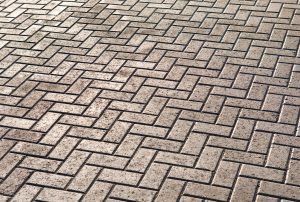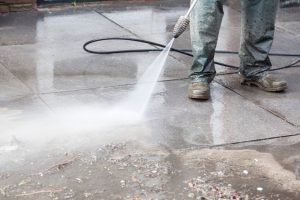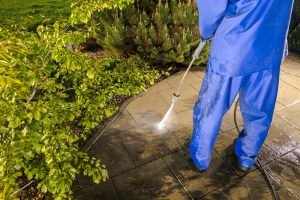Paver joints can be a tricky aspect to get right when it comes to landscaping, but with the right materials and techniques, you can ensure a long-lasting and beautiful finish. Polymeric sand is one such material that has been gaining popularity in recent years for its superior performance compared to traditional jointing sand. In this blog post, we will explore what polymeric sand is and the benefits it offers for your paver joints.
We will also provide guidance on how to choose the best polymeric sand based on various factors such as joint gap size, polymer type, drying time, and color options. Additionally, we will explain how to apply polymeric sand on your paver joints step-by-step and share our top picks for 2023. Lastly, we will answer frequently asked questions about polymeric sand so that you can make an informed decision if it’s the right choice for your paver joints.
What is Polymeric Sand?
Polymeric sand is a specialized type of sand designed for paver joints. It is made from a combination of silica and polymer binders that harden when hydrated. The result is a solid, durable joint that is resistant to erosion, weed growth, and insect infestations.
One of the biggest advantages of using polymeric sand is its ability to provide superior stability to your pavers. This helps prevent movement between pavers due to freeze-thaw cycles or heavy traffic over time. Additionally, polymeric sand helps prevent weeds, ants, and other pests from entering your paver joints, ensuring long-lasting durability.
Overall, polymeric sand has proven itself as a great investment for anyone who wants to maintain the look and integrity of their paver installation over the years.
Top Benefits of Using Polymeric Sand for Your Paver Joints
Polymeric sand is an excellent choice for your paver joints as it offers several benefits. It eliminates the problem of weeds and insects entering the joints, which can cause shifts, cracks, and erosion. The result is superior joint stability that lasts for a long time.
Another advantage of using polymeric sand is its ease of use and minimal maintenance requirements. You only need to apply it once, and it will last for several years without requiring any additional work. Plus, it prevents staining by preventing water and dirt from entering the joints. This ensures that your pavers always look clean and new. With all these benefits, choosing polymeric sand over traditional sand is a no-brainer when it comes to enhancing the performance of your paver joints.
Prevents Growth of Weeds and Insects
Polymeric sand is a premium paver joint sand that offers superior performance compared to regular sand. One of the top benefits of using polymeric sand is that it prevents the growth of weeds and insects in the joints between pavers, making it a preferred choice among professionals. Additionally, polymeric sand hardens after being exposed to water, creating an even stronger bond between the pavers that can help prevent erosion.
Another advantage of using polymeric sand is its high compaction rate, which further enhances its ability to withstand heavy foot traffic and other stresses. Unlike regular sand, the color of polymeric sand will not fade over time and can be easily swept away if necessary. Overall, using polymeric sand for your paver joints is a smart choice that can help increase the longevity and durability of your outdoor space.
Reduces Erosion and Washing Out of the Joints
Polymeric sand is a specialized type of sand that offers several benefits for paver joints. One of the top benefits is its ability to reduce erosion and washout of the joints, which helps extend the lifespan of your pavement. By binding together the pavers, polymeric sand helps keep them from shifting or moving, further enhancing their stability.
In addition to reducing erosion and improving stability, polymeric sand can also prevent weed growth and allow water to drain properly from the surface. This helps maintain the integrity of your pavement while also making it more visually appealing.
Overall, using polymeric sand for your paver joints can greatly enhance the performance and longevity of your pavement while also providing a neat and finished appearance.
Improves Stability of the Pavers
Polymeric sand is a superior option for filling in the joints between your pavers. One of its main benefits is that it helps to stabilize the pavers by filling in the space between them. This improves overall stability, making your patio or walkway safer and more durable.
Additionally, polymeric sand is resistant to weed and ant growth, keeping your outdoor area looking clean and neat. It can also withstand extreme weather conditions including heavy rains, making it ideal for outdoor use. Another advantage of using polymeric sand is that it resists staining from oil and other liquids, ensuring that your pavers will look like new for years to come.
Finally, one of the best things about polymeric sand is that it’s easy to apply and requires minimal maintenance. This makes it an ideal choice for DIYers who want to tackle their own landscaping projects without worrying about complicated installation processes.
Considerations When Choosing the Best Polymeric Sand
Polymeric sand is a popular choice for filling the joints between pavers. However, with so many options available in the market, choosing the best polymeric sand can be challenging. When selecting a polymeric sand, color becomes an important consideration. You want to choose a sand that matches the color of your paver so that it blends seamlessly with your overall design.
Strength and durability are also vital factors to consider when purchasing polymeric sand. The last thing you want is for the sand to crumble or wear away over time, which will compromise the structural integrity of your pavers. Therefore, select a product with superior strength and durability properties.
Before making a purchase, research on the brand by reading online reviews. This helps you get an idea of its performance and reliability from other customers’ experiences. Finally, choose polymeric sand that’s weather-resistant and can withstand extreme weather conditions like heavy rain or snowfall without breaking down quickly. By considering these factors when selecting polymeric sand, you can ensure optimal performance and longevity for your pavers.
Size of the Joint Gaps
When choosing the best polymeric sand for your paver joints, it’s important to consider the size of the joint gaps. Polymeric sand comes in a variety of grain sizes, so you’ll want to choose a size that fits your gap. The overall look and performance of the paver joints will depend on the size and shape of the sand particles.
In addition to size, consider the color of the polymeric sand. Choosing one that matches or complements your pavers can enhance its appeal. Finally, make sure to read all product information to ensure you are selecting a high-quality polymeric sand that won’t wash away with rain or water runoff. By taking these considerations into account, you can choose the best polymeric sand to achieve superior performance and longevity for your paver project.
Polymer or Adhesive Type
When selecting the best polymeric sand for your paver joints, it’s important to consider the type of polymer or adhesive used in the mix. Polymeric sand with a higher percentage of polymer content will provide superior performance and longer-lasting results. The adhesive type used in the sand can also affect how well the sand locks into place, so be sure to choose a product that is designed for your specific application.
Additionally, it’s important to note that some polymeric sands are designed to resist moisture and rain, while others are not. Be sure to choose a product that meets your specific needs, as this can have a big impact on the overall effectiveness and longevity of the sand. Overall, choosing the right type of polymeric sand is crucial for achieving superior performance and long-lasting results with your paver installations.
Drying Time
When choosing the best polymeric sand for your paver joints, drying time is an important consideration. Some polymeric sands can take several days to dry, while others can dry in just a few hours. Polymeric sand that dries quickly is ideal for quick and easy installation.
In addition to drying time, it’s also important to check the ingredients of the polymeric sand. Some brands contain chemicals that can be harmful if inhaled or ingested, so it’s important to select a product that is safe for both you and the environment.
Finally, make sure to select a polymeric sand that is specifically designed for paver joints. This will ensure the best results and long-lasting performance. By considering these factors, you can choose the best polymeric sand for your project and enjoy superior performance for years to come.
Colour Options
When it comes to choosing the best polymeric sand for your paver joints, there are several considerations to keep in mind. One of these considerations is the colour options available. Polymeric sand comes in a variety of colours, making it easy to match the look of your pavers. It’s important to choose a shade that will blend in with the pavers and not detract from their overall appearance.
Different shades of polymeric sand can also be used to create interesting patterns or designs, adding an extra element of visual interest to your patio or walkway. Additionally, polymeric sand is designed to resist fading and discolouration over time, ensuring your outdoor space looks great for years to come.
Finally, it’s important to consider the specific installation requirements of each type of polymeric sand before making a purchase. Some types may require more preparation or a specific kind of application technique, so make sure you read up on the instructions before beginning your project.
Consistency of the Sand
When choosing the best polymeric sand for your paver joints, there are several important considerations to keep in mind. One of the most critical factors is the consistency of the sand. Look for a product with a fine, uniform grain size that is free of clumps or chunks. The sand should also be non-staining and have minimal dust particles.
It’s also important to choose a sand that is specifically designed for use in paver joints, as this will ensure that it can withstand extreme temperatures, moisture, and other weather conditions. Additionally, choose a product that is easy to use and easy to clean up after application. By taking these factors into account when selecting your polymeric sand, you can achieve superior results and ensure that your paver joints remain stable and secure for years to come.
How to Apply Polymeric Sand on Your Paver Joints
Applying polymeric sand to your paver joints is a simple process that can significantly improve the performance of your pavers. Start by preparing the area and removing any existing weeds or grass from between the pavers. Once the area is clean, sweep in polymeric sand between the pavers and spread it evenly over the area. Use a broom to sweep the polymeric sand into the joints of your pavers, making sure that each joint is filled completely.
After applying, activate the polymers by using a garden hose to spray water over the area. Make sure that you soak every inch of sand with water, and let it set for 24 hours before walking on it or using it. The final result will be strong, stable joints that hold up against weathering and heavy use – all thanks to the powerful binding agents in polymeric sand!
Equipment and Tools Required
When it comes to applying polymeric sand on your paver joints, having the right equipment and tools is essential. Before you begin, ensure that you have a broom, rubber mallet, masonry brush, gloves, goggles and garden hose on hand. Additionally, you will need a wet/dry vacuum or shop vac to clean up any excess sand.
To apply the sand, start by pouring it over the paver surface in thin layers. Use the rubber mallet to tamp down each layer firmly between the pavers. Continue adding layers until the sand reaches the desired height. Once complete, use a garden hose to gently mist the surface of the pavers and activate the polymeric sand. Finally, use a broom to sweep away any remaining sand from the surface of the pavers.
Preparation of the Paver Surface
Applying polymeric sand to your paver joints can greatly enhance the durability and stability of your outdoor space. Before applying the sand, it’s important to properly prepare the paver surface. This includes thoroughly cleaning the surface of any dirt and debris, as well as removing any pooled water from the joints.
Once the surface is prepared, wetting the pavers prior to application will help the sand settle into the joints more easily. Using a broom, sweep the polymeric sand into each joint completely. Once all joints are filled, lightly mist with water so that the sand will harden and bind together.
Properly applying polymeric sand will ensure a superior performance for your outdoor living area. Not only will it provide added stability to your pavers, it will also help prevent weed growth in between them.
Application and Spread of the Sand
Polymeric sand is a specialized product that is designed to fill paver joints and prevent weeds and ants from entering. Unlike traditional sand, it is easy to install and requires no mixing or curing time, making it an ideal choice for anyone looking for a quick and simple installation process.
When applying polymeric sand, it’s important to make sure that the pavers are completely dry before beginning. The sand should be evenly spread across the paver joints using a broom or tamper, ensuring that all areas are filled. Once applied, the sand should be lightly tamped down to ensure a secure fit.
After application of the sand, it’s important to allow it to cure for 24-48 hours before watering or any traffic is allowed on the surface. This ensures that the sand has fully adhered to the pavers and will provide long-lasting joint stabilization. Overall, polymeric sand can greatly enhance the performance of your paver surface by providing added stability and weed prevention.
Sweep and Tamp the Sand into the Joints
When it comes to applying polymeric sand to your paver joints, there are a few key steps to follow for optimal performance. First, you’ll want to make sure that any old sand and debris is removed from the joints before applying the polymeric sand.
Once the joints are clean, use a broom to sweep the polymeric sand into the cracks until all gaps are filled. After that, it’s essential to tamp down the sand firmly into place.
Finally, misting the joint with a garden hose fitted with a misting attachment will activate the polymeric binder and set the sand in place. Following these steps will help ensure that your paver installation remains weed-free and insect-resistant for years to come.
Mist and Cure the Sand
Applying polymeric sand to your paver joints is a simple process that can provide superior performance and long-lasting protection for your pavers. To get started, use a push broom to sweep the specialized sand into the joints between your pavers.
Once the sand is in place, mist the joints with water and allow it to cure for 24 hours. This will help the sand settle into place and create a strong bond with your pavers. After curing, use a blower or broom to remove any excess sand from the surface of your pavers.
Misting and curing the polymeric sand is an important step in ensuring its effectiveness. By following these steps, you can ensure that your polymeric sand will keep your pavers in place and protect them from wear and tear over time.
Top Picks for Polymeric Sand in 2023
Polymeric sand has become increasingly popular for filling paver joints because of its superior performance over traditional sand. But with so many options available in the market, it might be challenging to choose the right one. When selecting polymeric sand, consider key features such as erosion resistance, weather durability, and ease of installation. It is also essential to compare research data on permeability, compaction, weed growth prevention, and colorfastness.
Another important aspect to consider is cost, availability, and customer feedback. Buying high-quality polymeric sand ensures the best performance results for your project. If you’re unsure which brand or type of polymeric sand to choose from, we recommend consulting with a professional installer or supplier who can help you select the best option for your specific needs. By doing so, you can expect a long-lasting and beautiful result for your paver installation project.
Our Verdict: Is Polymeric Sand the Right Choice for Your Paver Joints?
Polymeric sand is an excellent choice for paver joints. It offers superior performance compared to ordinary sand and can help prevent weed growth, insect infestation, and erosion. The application process of polymeric sand is quicker and easier than traditional sand. Therefore, it helps save time and effort while providing a more secure bond between your pavers. The polymeric sand-filled joints are much stronger and can withstand harsh weather conditions such as heavy rains, snow, or ice. It’s essential to select the correct type of polymeric sand for your project and follow the application instructions carefully. Overall, if you want long-lasting results with minimal maintenance, then polymeric sand is undoubtedly the right choice for your paver joints!
Frequently Asked Questions (FAQs) about Polymeric Sand
If you’re considering using polymeric sand for your paver joints, you may have some questions about its benefits and application. Polymeric sand is known for its superior performance compared to regular sand, offering long-term durability and stability for your pavers. The application process involves first cleaning the paver surface and filling the joints with dry polymeric sand. The sand is then activated using water, which helps it harden and bind the pavers together. This process ensures that the pavers remain stable under heavy foot traffic or weather changes.
Polymeric sand is a preferred choice for many homeowners because of its long-lasting durability, resistance to weed growth, and ability to resist erosion or washouts caused by rainwater runoff. It is also easy to install and does not require any additional tools or equipment. If you’re looking for a superior option for your paver joints, polymeric sand is definitely worth considering!
Can Water Drain Through Polymeric Sand?
One frequently asked question about polymeric sand is whether water can drain through it. While polymeric sand does not absorb water, it does allow for some drainage which keeps water from pooling between pavers. This is an important feature as standing water can cause damage to pavers and create a breeding ground for insects.
Polymeric sand is a specialized type of sand that hardens when exposed to water. It is specifically designed to fill the joints between pavers and keep them from shifting or moving. The binding agent in the polymeric sand helps prevent weeds from growing in paver joints and makes them more resistant to erosion. Overall, polymeric sand offers superior performance compared to traditional jointing materials and is an excellent choice for anyone looking to improve the durability and longevity of their paved surfaces.
How long does Polymeric Sand Last?
Polymeric sand is a durable option for filling in paver joints that can last for years, depending on climate and usage. It is resistant to rain, wind, and extreme temperatures, making it a great choice for outdoor applications. Polymeric sand provides better stability to your pavers and reduces weed growth between joints. Additionally, it can help prevent ants from entering the joints of your pavers. However, the longevity of polymeric sand depends on proper installation and regular maintenance. If installed correctly and maintained properly, polymeric sand can be a cost-effective solution that provides superior performance for your paver joints.
What is the Difference between Jointing Sand and Polymeric Sand?
One of the most common questions about polymeric sand is how it differs from traditional jointing sand. Jointing sand is a mixture of regular sand and other materials, used to fill gaps and joints between pavers. It can be easily displaced by wind, rain, or vehicular traffic, and often requires frequent reapplication.
Polymeric sand, on the other hand, is a special blend of sand and binders that hardens when activated with water. Once installed, polymeric sand becomes firmly embedded in the joints between pavers and creates a strong bond. Additionally, polymeric sand is resistant to weeds, insects, and erosion caused by weather conditions. To activate the binding agents in polymeric sand, misting it with water after installation is necessary. Overall, polymeric sand offers superior performance compared to traditional jointing sand when it comes to durability and longevity in maintaining your paver surface.
Conclusion
Polymeric sand is a versatile solution that can help you achieve superior performance for your paver joints. It offers numerous benefits such as preventing weed growth, reducing erosion, and improving the stability of pavers. Choosing the right polymeric sand is crucial, and considering factors such as joint gap size, polymer type, drying time, colour options, and consistency of sand will ensure optimal results. To apply polymeric sand on your paver joints, prepare the surface, apply the sand, sweep and tamp it into the joints, mist and cure it. If you’re looking for reliable commercial quotes for polymeric sand installation services or need professional advice on choosing the best option for your needs, contact us today.
Frequently Asked Questions
What is polymeric sand and how does it differ from regular sand for paver joints?
Polymeric sand is a specialized mixture of fine sand and polymer additives that, when activated with water, hardens to create a strong bond between paver joints. Unlike regular sand, polymeric sand is more effective at preventing weed growth and erosion.
However, proper installation techniques and curing time are necessary for optimal performance. It’s important to follow manufacturer instructions carefully to ensure the best results.
What are the benefits of using polymeric sand for my paver project?
Using polymeric sand for your paver project has several benefits. It is more durable than regular sand and prevents weed growth, helping to stabilize the pavers and prevent shifting over time. When exposed to moisture, the sand hardens, creating a strong bond between the paver joints. Additionally, it comes in a variety of colors to match your desired aesthetic. Overall, using polymeric sand can ensure that your paver project remains sturdy and visually appealing for years to come.
Can polymeric sand be used on all types of pavers or only specific ones?
Polymeric sand can generally be used on most types of pavers, including concrete, brick, and natural stone. However, it is crucial to check the manufacturer’s instructions to ensure compatibility with your specific type of paver. Using the wrong type of sand can cause discoloration or damage to your pavers.
To avoid any potential issues, it is best to consult with a professional before using polymeric sand on your pavers. They can help determine if it is a suitable option for your paving project and provide guidance on proper installation and maintenance.
How do I properly install polymeric sand for best results?
To properly install polymeric sand for the best results, start by cleaning the paver joints thoroughly and letting them dry completely. Next, spread the polymeric sand evenly over the surface, making sure it fills all gaps. Use a compactor or tamper to ensure that the sand is tightly packed.
It’s important to follow the manufacturer’s instructions for watering and curing time to ensure that the sand sets correctly. By taking these steps, you can achieve a durable and long-lasting surface that will look great for years to come.








